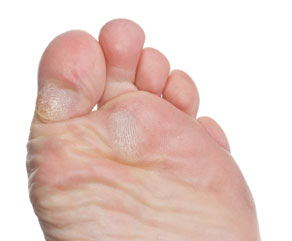It is a common condition for adults to have hard skin on the bottom of their feet. For most people, it is not painful and doesn't cause an issue with walking. It is mostly a cosmetic issue that often makes it embarrassing to go without shoes, but shoes are part of the problem. Your feet hold up your body weight and ill-fitting shoes can increase the pressure on your feet. Going barefoot can also cause issues, as well as, chronic health conditions. This article will answer your questions as to why this happens, how you can deal with it, and when you should contact a doctor for help.

Why Does Hard Skin on Feet Keep Coming Back?
If any hard skin on feet keeps coming back, it may be either related to a general health condition, or how you are taking care of your feet. The reason it is coming back depends on a few things:
- What does the skin underneath look like?
- Is the skin hard all over the bottom of the foot?
- Are there signs of infection such as swelling, redness, pain, yellowed skin, or odor?
- Do you have patches of hard skin where your shoes rub?
- Is your body wash or lotion irritating your skin?
- Do you go barefoot often on pavement or hot surfaces?
- Do your shoes fit right?
- Do you have a chronic health condition?
Answering any of these questions may give you some clues to your question, and you can take the steps to fix the problem. Let's take a deeper look at some of the causes:
1. Fungal Infections (Athlete's Foot)
Fungal infections of the foot are also known as, Athlete's Foot. They are caused by overgrowth of yeast. They like warm, moist, dark places and happen if your shoes are too tight and feet get sweaty. It can also be picked up in public swimming or bathing areas. If not treated completely, they have very high potential for recurrence, and hard skin may come back with the infection.
Symptoms of fungal infections of the foot include red rash that appears scaly, itching (sometimes severe), burning, and thickened skin.
2. Psoriasis
Psoriasis is an autoimmune condition of the skin that may affect the feet. It can cause chronic foot discomfort due to thick, hard skin. Palmoplantar pustulosis is a type of psoriasis that affects the feet. Trauma and poor foot care can make this type of psoriasis very hard to manage and the hard skin on feet keeps coming back. Since this is an autoimmune condition, steps need to be taken to keep the underlying immune system issues under control.
Symptoms of psoriasis of the feet include thick, dry, and cracked foot skin, blisters filled with fluid, itching, foot pain, and flaking skin.
3. Scleroderma
Scleroderma affects the connective tissues in your body, including the skin. It causes skin cells to become unusually thickened with lack of ability to stretch. The skin on the feet can be affected and affect other tissues in the body. If left untreated, it can permanently damage the skin.
Symptoms include hard, thick skin, joint pain, ulcers on skin, and rashes.
4. Atopic Eczema
This skin condition happens in children, but adults can suffer from it as well. It is a chronic condition and related to allergies and asthma. Flares can be triggered by certain foods, soaps, lotions, and seasonal allergies. Eczema can affect the skin on the feet and will keep coming back when the condition flares.
Symptoms of Atopic Eczema include itching, red or brown patches of thick skin, red bumps with fluid inside, sensitive and raw skin.
5. Xerosis
Xerosis is simply the name for dry skin. It causes dryness of any area of skin on the body. You may notice the hard skin on feet keeps coming back, even if you are giving yourself good foot care. This could mean that the dry skin issue is happening from the inside out due to not drinking enough fluids. You may also have naturally dry skin.
Symptoms include dry, flaky, and peeling skin, itching, raw areas from scratching, and a leathery like appearance. Skin that does not have enough fluids may regenerate, but not shed like it is supposed to. This causes buildup of thick patches.
6. Walking Barefoot
Your feet are designed to protect themselves. If you walk barefoot on hard asphalt, or on hot surfaces, the skin on your feet will thicken up on its own. Even if you practice good foot care and remove the skin, it will keep coming back hard if you repeatedly go without shoes.
Best Treatments to Deal with It
There is help available if the hard skin on feet keeps coming back. Good foot care can help soften foot skin and keep it soft. Removing excess skin cells and giving your feet optimal conditions will help them thrive. Try these helpful tips:
1. Practice Good Foot Care
Buy a quality foot care set that has a file or a pumice stone. Soak your feet and scrub away any dead skin cells. After you clean the old skin, apply a good moisturizer.
2. Drink Extra Fluids
If you are not getting enough fluids, the skin on your feet may be unusually hard to remove and thicken into callouses. Your feet need good blood flow, oxygen, and moisture to stay health. One way to increase circulation is to increase fluids.
3. Buy the Right Shoes
Make sure your shoes have enough room for your feet. Try to avoid shoes with "pointy" toes and tight fitting heels. If your shoes rub on your feet, they will build up a protective layer of skin from the friction.
4. Keep Feet Dry
Warm, moist feet can invite excess skin growth, and put you at risk for a fungal infection (Athlete's Foot). Keep your feet dry, wear good socks to wick away any moisture, and cushion your feet.
